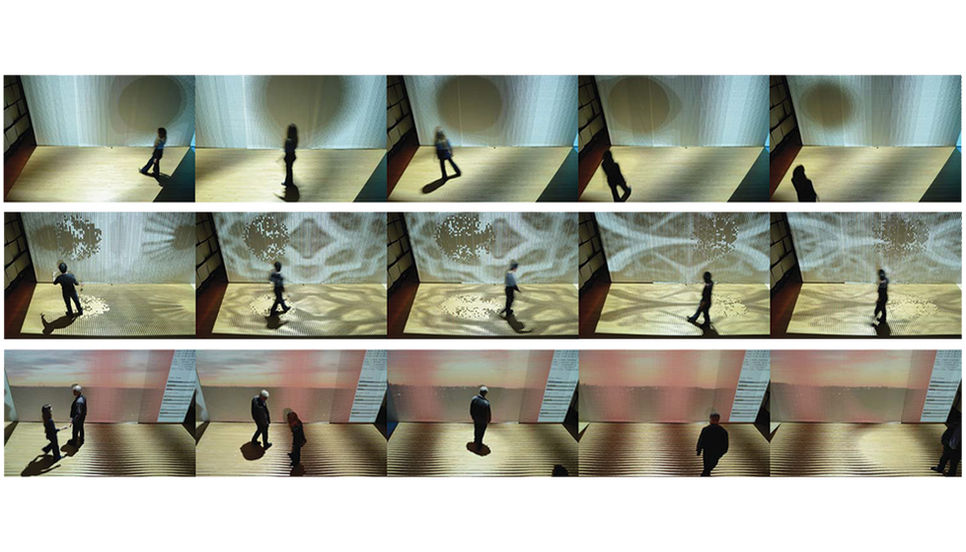

systems
main question
Recently developed thin-film electro electropolymeric display prototypes demonstrate a significant new opportunity for dynamic façade applications that enable instantaneously switchable patterns to be embedded within the surfaces of insulated glazing units. In order to keep pace with rapidly advancing research towards responsive building technologies on multiple fronts, new robust frameworks are required to address the multi-scalar complexity, environmental, and socio-cultural performance possibilities inherent within their material behavior.
In exploring methods to integrate bioclimatic and biological inputs in the design and testing of highly responsive technologies such as the Electroactive Dynamic Display System (EDDS), addressing environmental modulation, building demands, design intentions, and the diverse preferences of building inhabitants is essential. Our design methodology investigates these challenges through a visually immersive computational framework that integrates both quantitative and qualitative real-time feedback into the design and testing procedures for developing next-generation bioresponsive building envelopes.
Controlling solar heat gain associated with daylight is a significant challenge. In order to offset building heating and cooling loads associated with diurnal and seasonal variations in climate, a range of adaptable responses at the window is required. In contrast to existing dynamic building envelope technologies, emerging display technologies have the potential to actively reconfigure their basic patterns to respond to fluctuating bioclimatic flows while simultaneously adjusting to the changing visual desires of occupants.
Can we create dynamic buildings that adapt their surfaces bio-responsively?

Image: Cover of Advanced Materials Magazine 2015
gallery:

gallery:
team
collaborators
selected
publications
sponsors
U.S. D.O.E., NYSERDA, NYSTAR
Anna Dyson, Bess Krietemeyer, Jason Vollen, Peter Stark, Brandon Andow, Nikhil Koroktar, K.V. Lakshmi, Nicholas Holt.
Industry: SHoP Architects, Skidmore, Owings & Merrill LLP (SOM), Arzon Solar, HeliOptic LLC
Can we create dynamic buildings that adapt their surfaces bio-responsively?


Renewable bio-based circular material economies in timber, post-agricultural by-products and plant-based bioremediation
Add a Title
EDDS
ELECTROACTIVE
DYNAMIC
DISPLAY
SYSTEMS
Anna Dyson, Bess Krietemeyer, Jason Vollen, Peter Stark, Brandon Andow, Nikhil Koroktar, K.V. Lakshmi, Nicholas Holt.
Elizabeth Krietemeyer, Shane Smith + Anna Dyson (2011)
Electroactive Polymer Actuators and Devices (EAPAD) 2011. Vol. 7976. International Society for Optics and Photonics (2011)
Recently developed thin-film electro electropolymeric display prototypes demonstrate a significant new opportunity for dynamic façade applications that enable instantaneously switchable patterns to be embedded within the surfaces of insulated glazing units. In order to keep pace with rapidly advancing research towards responsive building technologies on multiple fronts, new robust frameworks are required to address the multi-scalar complexity, environmental, and socio-cultural performance possibilities inherent within their material behavior.
In exploring methods to integrate bioclimatic and biological inputs in the design and testing of highly responsive technologies such as the Electroactive Dynamic Display System (EDDS), addressing environmental modulation, building demands, design intentions, and the diverse preferences of building inhabitants is essential. Our design methodology investigates these challenges through a visually immersive computational framework that integrates both quantitative and qualitative real-time feedback into the design and testing procedures for developing next-generation bioresponsive building envelopes.
Controlling solar heat gain associated with daylight is a significant challenge. In order to offset building heating and cooling loads associated with diurnal and seasonal variations in climate, a range of adaptable responses at the window is required. In contrast to existing dynamic building envelope technologies, emerging display technologies have the potential to actively reconfigure their basic patterns to respond to fluctuating bioclimatic flows while simultaneously adjusting to the changing visual desires of occupants.

























